There aren’t many luxury sedans on the market anymore. There are lots of luxury-sport sedans.
It’s not a small difference.
Luxury-sport sedans have the amenities – and the prestige. They also tend to have firmer-riding suspensions and seats. How else to be . . . sporty?
One of the few that doesn’t try to be – and for that reason is more luxurious – is the Lexus ES350 sedan.
What It Is
The ES350 is a medium-large luxury sedan that focuses, laser-like, on comfort. One metric of which is roominess. Which the ES has slightly more of than Lexus’ top-of-the-line luxury-sport sedan, the $76,000 to start LS500.
You can buy a new ES350 for $40,800 to start.
$45,450 with the optional all-wheel-drive system.
It’s also the last Lexus sedan that still comes standard with a V6 . . . other than the LS.
What’s New
The 2022 ES350 features revised exterior styling and a number of functional upgrades, including standard auto-leveling LED headlights, revised rear suspension tuning that Lexus says makes the ES ride even more comfortably – plus a repositioned closer-to-the-driver LCD touchscreen and Left Turn Intersection Assist, an evolution of the Lane Keep Assist systems already found in many new cars. This one looks out – electronically – for other cars in your intended travel path and applies countermeasures such as braking/steering correction if needed to avoid a collision.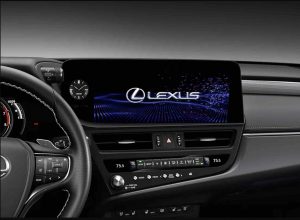
What’s Good
One of the most comfortable – luxurious – new cars available.
Among the slowest depreciating new cars available, period.
The ES350’s standard V6 is itself becoming a luxury.
What’s Not So Good
Limited cargo capacity (13.9 cubic feet of trunk space) further limited by rear seat backs that can’t be folded down.
A wireless charger for your phone is available but not standard.
Some desirable options require stepping up to the more expensive Luxury ($46,200) and Ultra Luxury ($49,800) trims to have access to, including the foot-swipe trunk opener
Under The Hood
The ES350 isn’t just one of the few luxury sedans you can still buy new, it is also one of the few new sedans – period – that still comes standard with a V6 rather than a turbocharged four.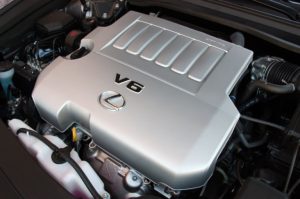
It displaces 3.5 liters and produces 302 horsepower – which for reference is nearly twice the size of the much smaller – and much less powerful – 2.0 liter fours that come standard in luxury-sport sedans like the BMW 5 Series (248 hp) and Mercedes E350 (255 hp).
Both of which also cost about $14k more to start ($54,200 and $54,250 respectively) than the ES350.
An eight speed automatic is standard as is front-wheel-drive but you have the option to go all-wheel-drive, if you’d like more poor weather grip.
Even without it, the FWD Lexus has better poor weather grip than the RWD versions of luxury-sport sedans like the BMW 5 and Mercedes E, since it is better to pull than push (and to have the weight of the drivetrain over the drive wheels) when the road is slick.
Benz and BMW buyers who want more grip have more need of AWD, which inflames the already high cost of those cars to even higher – $56,500 and $56,750 respectively – which is about $10k more than Lexus asks for an AWD-equipped ES with a standard V6.
To get a six in the BMW or the Benz, you’re looking at spending $60k-plus, or some $20k more than it costs to get an ES350 with a six.
Now, it is true that these luxury-sport sedans are . . . sportier. They get to 60 a bit more quickly – just over 5 seconds vs. just over 6 for the Lexus – but not because they’re stronger. They are geared more aggressively, being . . . sporty. The Lexus would probably be quicker if it had a final drive ratio more aggressive than 2.56 but then, it is not trying to be sporty.
The V6 delivers the luxury of quiet, easy pull – without the sporty power delivery of a little engine being breathed on.
It also delivers about the same – or even slightly better – advertised gas mileage than its turbo-four-powered luxury-sport sort-of-competition: 22 city and 32 highway vs. 25 city, 33 highway for the turbo four-powered BMW 530i and 22 city, 31 highway for the turbo-four-powered Benz E350.
In real-world driving, the Lexus widens the gap – because its V6 doesn’t need the supplementation of boost to deliver the advertised performance. The little fours do. Under boost, they use more gas. And you’ll find you need to boost them regularly, if you want these cars to respond sportily.
Interestingly, bigger engines used to be synonymous with luxury.
There was a time – it wasn’t that long ago – when it was expected that spending $50k-plus would buy you at least a V6, if not a V8. It is a measure of our times that almost every $50k-plus car that’s available for 2022 comes standard with a four, the same size engine found in economy cars.
They have been given mouth-to-mouth (so to speak) with turbo boost, to get them to make more power than the four cylinder engines used in most – but not all – economy cars. But even if they made as much power as the six cylinder engines that were once expected in a $50k-plus car (or for that matter, a $40k car) there is still something disappointing about knowing your fancy luxury-sport car has an engine no bigger – and not much more potent – than the engines in many economy cars.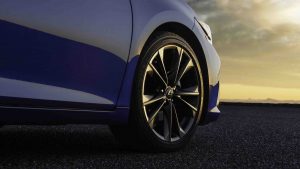
The ES350 doesn’t make you feel disappointment. There is pride in knowing you have a six – and they have fours. Even more so when you reflect upon the happy fact that you paid $14k less for yours.
There is also something to be said for sound.
It isn’t that four cylinder engines sound bad. Some sound very good – in sports cars, for instance – where high-pitched, high-revving sound are appropriate. But such sounds are as mismatched in a large sedan as a hunting rifle chambered for BBs. This is tacitly conceded by the makers of these large sedans equipped with fours, via sound augmentation technology. More fitting sounds are electronically piped into the car’s cabin, to make it sound as though there is something more than a four under the hood.
Of course, power – and acceleration – aren’t everything. At least, not in a luxury sedan.
Comfort is.
This is the specialty de’ la maison of the ES350. The thing it does best – because it is most focused on doing it while the others focus on trying to be comfortable and sporty, which is like trying to be cold and hot at the same time.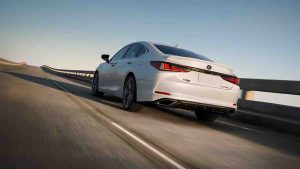
Usually, you end up warm.
The others are – as the car press often styles it – more “engaging” to drive. They have more grip in the curves when those curves are taken at high speed. Their steering is more sensitive and precise. But their rides are also . . . firmer. You hear more – from the shorter/stiffer sidewall tires needed to achieve more grip in the curves – when those curves are taken at high speed. You feel more – or rather, less – in your rear end, which goes numb sooner because the seats haven’t got as much give.
The ES makes the drive more . . . comfortable. The easy, unhurried power delivery of the big V6. The cushioning of the seats, which also don’t cinch your shoulder inward with “sporty” bolsters. This is a car that recalls what luxury cars were all about before almost all of them decided they had to try to be sporty, too.
At The Curb
Another metric of luxury is – was – spaciousness.
It still is, in the ES.
Up front, 42.4 inches of legroom for the driver and front seat passenger. In back, just shy of 40 inches for the rearseat occupants – which is about three inches more than in luxury-sport sedans like the Mercedes E350 (36.2 inches) and BMW 5 (37.5 inches). As mentioned above, the ES has slightly more backseat legroom than Lexus’ full-size luxury-sport sedan, the LS500 which has 38.9 inches vs. 39.2 in the more luxurious – in this respect, at least – Lexus flagship.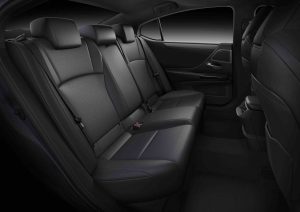
Inside, you’ll find a revised dash layout intended to make this already very pleasant-to-drive car even more so, via a closer-to-the-driver LCD touchscreen that lets the driver access functions by touch as well as the console-mounted controller. The previous system was not a touchscreen, which was one of the few things one could criticize about the ES350’s ergonomics.
An excellent 10 speaker Pioneer audio system is standard (and still comes standard with a CD player, something that’s become as hard to find in new cars as six cylinder engines) but it’s money very well spent to spring for the available seventeen speaker, 1,800 watt Mark Levinson PurePremium surround system.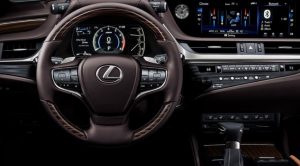
The optional quilted leather (real leather – not faux something-or-other trying to look but which will never feel quite as good as real leather) seats are also worth the spend.
The Rest
Lexus does offer a four cylinder-powered version of the ES – the ES250. This one comes standard with the all-wheel-drive system that is extra cost with the V6-equipped ES350.
Interestingly, the price for both (so equipped) is the same $40,800.
There is also a hybrid version of the ES – the ES300h. This one stickers for $41,900 and comes only with FWD. But it does come with an EPA mileage sticker of 43 city and 44 highway.
You can also buy F Sport versions of every ES – but it’s mostly meant to make the ES look sportier. Models so equipped get some body embellishments, larger wheels and some interior themes to spice up the appearance, such as Hadori aluminum-trimmed pedals and an instrument cluster similar to the one on the Lexus LFA supercar. They also get an auto-adjusting suspension with driver-selectable “sport” modes.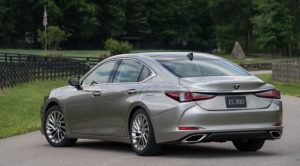
But don’t worry, it’s no less luxurious for it.
The one thing you don’t get in any ES is a big trunk – just 13.9 cubic feet small – which is the one objective detraction from this otherwise faultlessly luxurious sedan. It’s a deficit made worse by the fixed rear seat backs, which you can’t fold down to open up more space as you can in many other sedans.
The Bottom Line
In no small way, the ES350 is the last of the Mohicans.
If it had a bigger trunk, it’d be just about perfect.
. . .
Got a question about cars, bikes, Libertarian politics – or anything else? Click on the “ask Eric” link and send ’em in! Or email me at [email protected] if the @!** “ask Eric” button doesn’t work!
If you like what you’ve found here please consider supporting EPautos.
We depend on you to keep the wheels turning!
Our donate button is here.
If you prefer not to use PayPal, our mailing address is:
EPautos
721 Hummingbird Lane SE
Copper Hill, VA 24079
PS: Get an EPautos magnet or sticker or coaster in return for a $20 or more one-time donation or a $10 or more monthly recurring donation. (Please be sure to tell us you want a magnet or sticker or coaster – and also, provide an address, so we know where to mail the thing!)
My eBook about car buying (new and used) is also available for your favorite price – free! Click here. If that fails, email me at [email protected] and I will send you a copy directly!


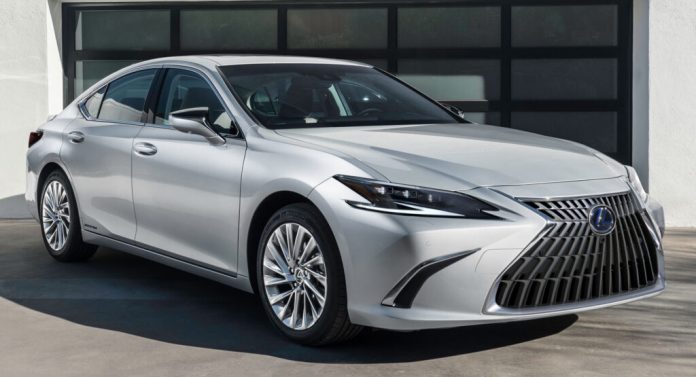

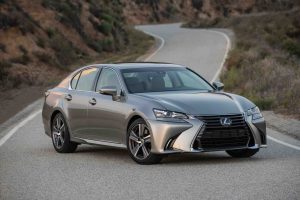








I only drive my wife’s “dream car” 2015 ES350 when it’s time to go to the dealer for service. On the way there, I usually marvel at what a nice, quiet luxury ride it is. On the way home, I’ve had enough of it and can’t wait to get out of the soul-less boat.
We bought my wife a used SUV version of the ES350 – aka the RX350 – with the same engine. It by far the nicest car I’ve ever owned and driven. It has the optional sportier low profile tires, which makes for a slightly rougher ride (we test drove RXs with both tire/wheel combos), but makes it even more capable for cornering and whatnot.
Not that I needed that capability – the things preventing the car from being driven at the limit is my abilities as a driver; the fact that almost invariably my wife is in the passenger seat, and she does not enjoy the considerably more aggressive driving style; and a plethora of cops.
The only thing I would want to change about this car is the somewhat rough patch the engine hits between about 1500 and 1700 RPM. You wouldn’t think would happen all that often, but the tall gearing and the transmission settings designed to squeeze maximum MPGs result in that range defaulting quite a lot in city driving. You have to get to 60+ MPH for the car to be constantly above that range.
Someone looking for a sportier car might actually like the noise and vibration in that engine range – dunno.
My last sedan was a 1970 Chevrolet Impala – 400 cu in Small Block V8, with a Turbo-Hydramatic 400 auto trans. Transmission was so good it was the trans of choice for Rolls Royse. After the Impala, it was hatchbacks, Camaro/Trans Ams, or SUVs. Would never buy a sedan, if the equivalent hatchback was available.
Hi liberty,
I’m a coupe guy, too – but I can be, on account of not having kids! The type of car I especially esteem – which no one sells anymore – is the large personal luxury coupe; something like a ’70s Eldorado or Pontiac GP. I’d also be very happy to ride around in an ’80s Monte Carlo SS . . . last of the carbureted muscle cars!
One of the best GM cars I owned is little known – a 2004 Chevrolet
Malibu Maxx (aka Opel Vectra). It’s a hatchback with standard V6, 4-speed auto, all the options, including remote start – handy in the winter.
It was popular with my son’s school friends, and was nicknamed the “limo” for its roomy back seat with separate adjustable seats/tracks and audio/video entertainment. He’s still driving it.
luxury car and FWD just don’t seem right.
thanks uncle for the end of v8 rear drive big lunging cars.
maybe i’m weird but i like the rolling feel of a big 4 door from the 70s. made me feel like i was up classing from a 4 banger econo car (which is where 4 cyls belong)
I agree with you in principle, Dan –
I also default to RWD (and body-on-frame) . . . but, if you haven’t driven an ES (or its Toyota-badged equivalent, the Avalon) I recommend a try out. The thing will remind you of how it used to be.
I was close to buying a 2007 Avalon to replace my 2003 Lexus ES300. The Avalon was nice and quiet, but if it were possible had less personality than the Lexus. Given the ridiculousness of used car prices, I opted to keep the Lexus for a little while longer. The Avalon 3.5 L V6 is a silky smooth performer with plenty of go when you press on the happy pedal. It was when you turned the steering wheel, it felt like it was full of Novocain.
As long as Lexus continues to insist on those disgusting looking grills I will never own one no matter how good they are.
have to agree. It is off putting
It’s a nostalgic hat tip to vintage steam locomotives.
https://thumbs.dreamstime.com/b/locomotive-469032.jpg
Are you not entertained?
Northern Pacific called, they want their cow catcher back!
See also Salvador Dali melting clocks. And / or not polite to drive with your mouth open.
With computer modeling and carbon fiber fab surprised a customizer hasn’t come up with an attractive front clip for these rigs.
I like the exterior and interior of Audi’s more, the Lexus has a better reputation for reliability.
VAG Volkswagen Audi Group just bought Mclaren.
The British made lots of different sports cars years ago, now there isn’t many left, Lotus, MG, are Chinese, Caterham is Japanese, Morgan is Italian, just a week ago Mclaren was owned by Bahrain, one the last surviving is Dutton, the largest kit car maker in the world in the 1980’s, it made 8000 Super 7 clones (Lotus only made 2500), , as well as a small pickup, a small SUV and their amphibious car, it is the only profitable amphibious car maker in the world, that is all they make now, it is also the oldest car manufacturer in the world that is still owned by it’s original owner.
https://www.zerohedge.com/markets/audi-purchases-mclaren-future-entry-formula-1-racing
Dutton Super 7 clone with SBC V8 434ci, 1600 lb, steel tube frame, fibreglass body, it has run a best 8.90 sec 1/4 mile, this is how a car should be, small, light, agile, fast, no frills, mechanical art made to go fast only, no luxury, no doors or roof, some have no windshield, nothing extra, it is quicker then all the hypercars and the tesla plaid.
A super 7 (a 1957 design by Lotus), is the ultimate driving experience, buy or test drive one, it is a completely different experience. The most direct, analog, raw, visceral, unfiltered driving experience.
A Donkervoort a Super 7 clone in 2003, 2004 had the world record lap time for any street legal car on the Nurburgring.
A Super 7 the 2nd most copied car in history, 160 companies made copies, (Cobra was the most copied car), the Super 7 is a close copy of a 1913 Bugatti Type 22, the specs are close, one of the first small light cars (did Lotus copy it?).
https://www.youtube.com/watch?v=Vn2lHb7N3uQ
Hey Eric,
We have an RX350, which we love. The only complaint is there is not a dang seek button, probably for my safeeeety.
I suspect the ES350, and most new vehicles have the same feature.
I miss being able to simply push a button and find the next station. At least I can take my eyes off the road a few seconds to fumble with the mouse button and locate the scan function.
I’m with you, Topspin –
I’d like both options, as it’s sometimes nice to be able to manually fine-tune as well as seek/scan. That said, I was surprised – and pleased – to find a CD slot in this 2022 model car… like many people, I still have a huge collection and it’s nice to be able to play them without having to digitize them!
New cars are so severely over styled, in my completely personal opinion. They harken back to the late 50s early 60s in US cars. Has Chevrolet ever made a more ugly car than their 58s?
Same here. Those lumpy-bumpy late 50’s DeSotos and Edsels were really repulsive too.
I tend to think the peak of American car styling was sometime in the late 60’s, with the fuselage (“Coke bottle”) styled Plymouths and Chevys. The 67 Firebird, Camaro, Corvair Monza, Corvette, Plymouth Barracuda, etc. were very nicely done IMHO. After that, things got bulldog-beefy (like the 70’s Mustangs and ‘Cuda), then malaise-era-styled. Heck, even the 1967 Cortina was a really nice looking motorcar.
New cars have virtually no styling whatsoever. They all share the same general shape as if they copied from eachother. The facts are these, government regulations force carmakers to style them the same way. That reduces their costs, as only one set of designers is contracted across several car companies. Car comapnies win against their customers again.